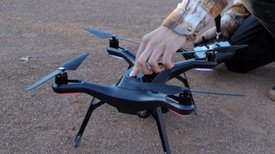Counting by drone not only saves time and effort, but yields better data on species numbers—a definite plus in terms of conservation.
使用无人机计数不仅省时省力,还能针对物种数量带来更好的计数结果——对动物保护来说无疑是十足的助力。
播音\撰文:卡伦•霍普金(Karen Hopkin)
翻译:陈美娟
审校:杨枭
Ecologists crouching quietly amidst vegetation, using binoculars to tally birds in a roost, may soon be a charming relic of the past. Because a new study shows that, when it comes to getting an accurate avian head count, aerial drones can do better.
生态学家静静地蹲在植被中使用双筒望远镜计算鸟巢中鸟的数量,这一举动可能很快成为迷人的过去时。因为一项最新的研究发现,如果想要获得准确的鸟类数量,无人机要比生态学家做得更好。
In recent years, scientists who study wild populations are increasingly turning to remotely piloted aircraft…otherwise known as drones…to monitor their animal of interest. For example, drones are being used to track pods of whales…or to keep an eye on African elephant herds and watch for signs of poaching.
近年来,越来越多研究野外群体的科学家转而选择远程遥控飞机—— 也就是无人机——来监控他们的目标动物。例如,无人机正被用于追踪鲸鱼群,或用于关注非洲大象群体,并密切留意(可能有的)偷猎迹象。
Such remote surveys are generally considered highly cost-effective. But it wasn’t clear whether they are as accurate as old-fashioned, feet-on-the-ground, expert evaluations.
人们普遍认为这些远程研究手段非常高效,但并不是很清楚这样得出来的结果是不是和以前那种让专家蹲在地上数的结果一样精确。
To find out, researchers in Australia set up a test.
为了得到这个答案,澳大利亚的研究者设计了一个实验。
“And so what we did was make some replica seabird colonies where we knew the true number of individuals in each colony.”
“我们所做的是根据已知群落的真实个体数量复制一些海鸟的群落。”
Jarrod Hodgson of the University of Adelaide led the study.
来自阿德莱德大学的贾罗德·霍奇森(Jarrod Hodgson)主持了这项研究。
Using decoy-sized rubber ducks, the researchers laid out 10 colonies…ranging in size from about 500 to more than 1,000 individuals.
研究者将假鸟(伪装鸟)大小的橡皮鸭放置到群落中——这些群落的大小从500到1000个个体不等。
“We then had experienced ground counters make independent counts of those birds from nearby, from the optimum vantage point. At the same time, we flew a drone overhead capturing photographs at different heights above the colony.”
“然后,我们在最佳观测点放置了地面感应计数器,互不干扰地计数附近每一只鸟。同时,我们在上空放飞无人机来捕捉来自该群落不同高度的图像。”
The drone data were then analyzed two ways. First, a gaggle of citizen–scientists was tasked with adding up the number of birds they could see in each scene.
随后,研究人员花了两天时间分析无人机数据。首先,一群鸟类居民出现在图像中——科学家们的任务是将他们看到的每一只鸟计入总数中。
The results of that approach:
“We found that on average the drone-derived data or the drone-derived counts made by humans counting the images were between 43 percent and 96 percent more accurate than the traditional ground-based counts.”
这种方法的结果是:“我们发现,我们根据计算无人机返回的数据计算的平均值比传统的地面计数值精确了43%到96%。”
The better the image, the more accurate the count.
返回的图像质量越好,计数值就越精确。
Then, Hodgson and his team developed a semi-automated computer program to do the counting for them. And they found:
“… there was no statistical difference between those counts and the counts completed by our volunteers using exactly the same imagery.”
The results appear in the journal Methods in Ecology and Evolution. [Jarrod C. Hodgson et al., Drones count wildlife more accurately and precisely than humans]
这之后,霍奇森与他的团队开发了一种用于计数的半自动计算机程序。他们发现:“……这些计算机算出来的结果与志愿者们根据同样图像计算的结果之间没有数据上的差别。”这项研究结果发布在《生物学与进化趋势中的方法》杂志中。
So counting by drone not only saves time and effort, but yields better data…a definite plus in terms of conservation.
因此采用无人机不仅省时省力,还能还能针对物种数量带来更好的计数结果——对动物保护来说无疑是十足的助力。
“When we monitor wildlife, increasing the accuracy and the precision of animal surveys gives us more confidence in our population estimates. And this means that we have a stronger evidence base on which to make management decisions or policy changes.”
“当我们监控野生动物时,越来越多既精准又简便的动物实验方法让我们对估计种群数量有了更多信心。这意味着我们能为决策管理或是政策变化给出更强有力的证据。”
In other words, a drone in the sky is better than two PhDs in the bush. Who can rely on better data to be feathers in their caps.
换句话说,飞在空中的无人机比躲在树丛中的两个博士更好,因为这能像锦上添花一样得到更好的数据。

 京公网安备11010502039775号
京公网安备11010502039775号  京公网安备11010502039775号
京公网安备11010502039775号 
















